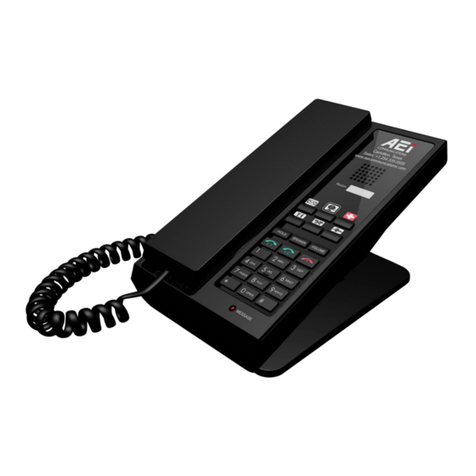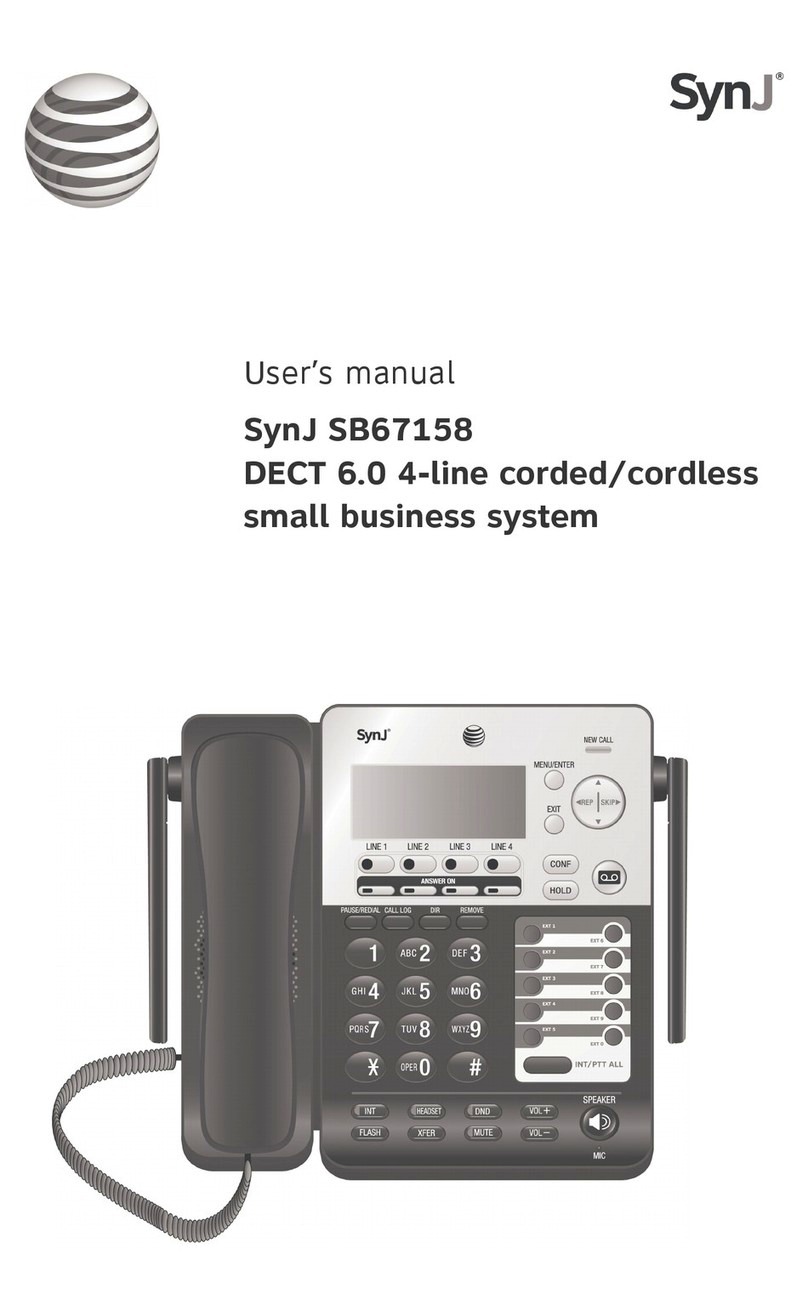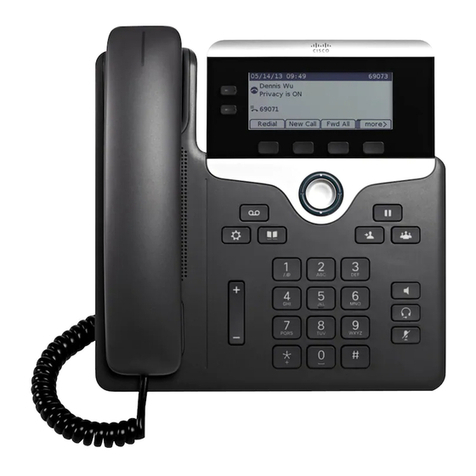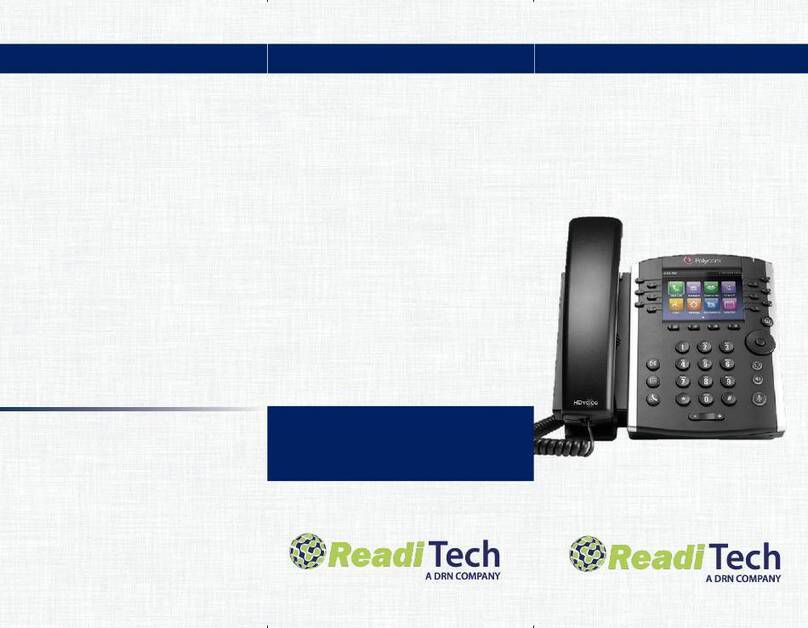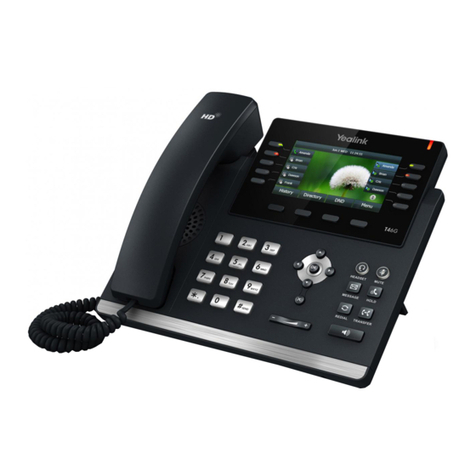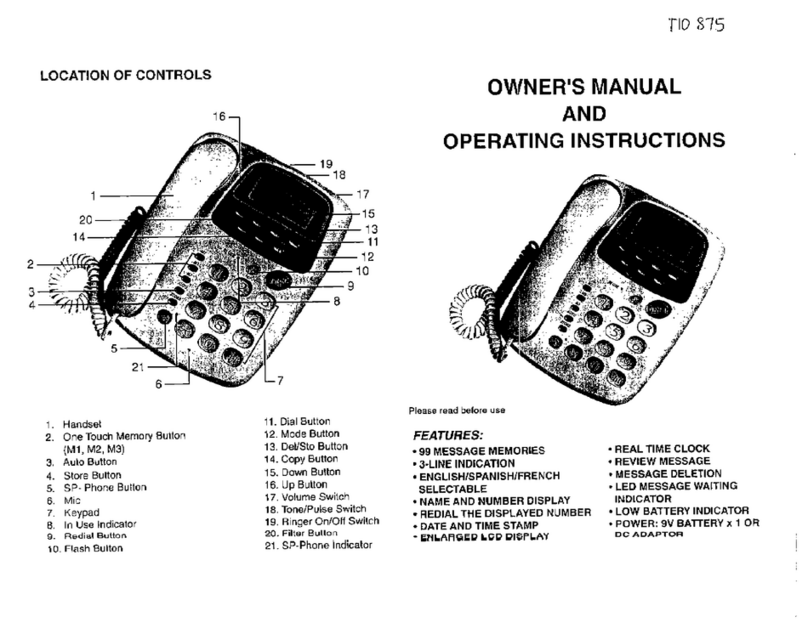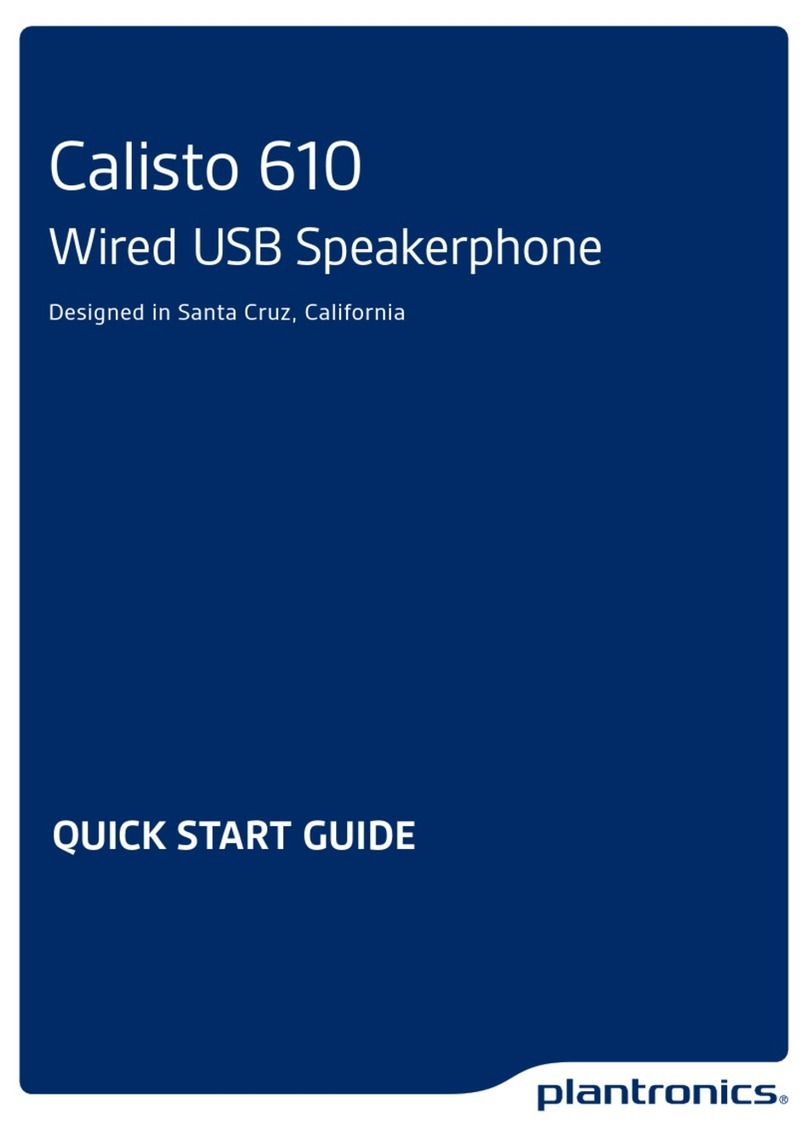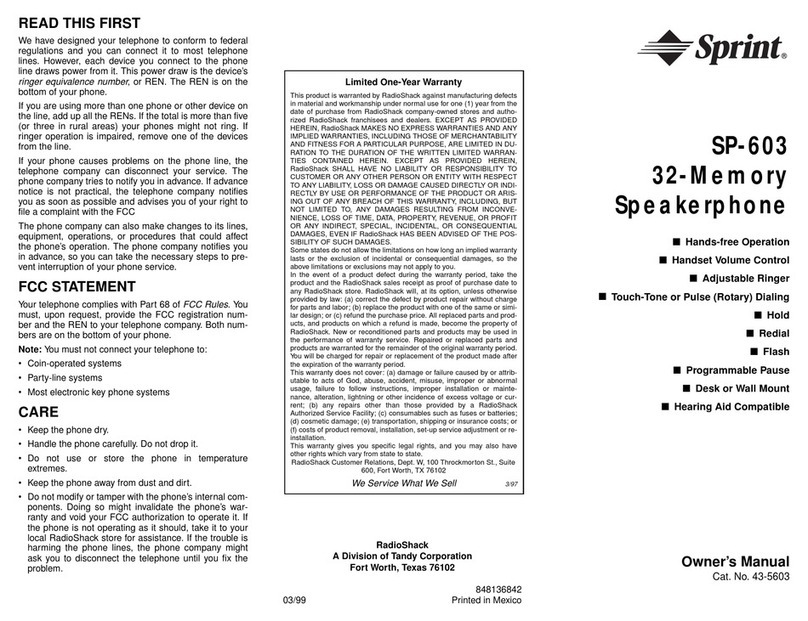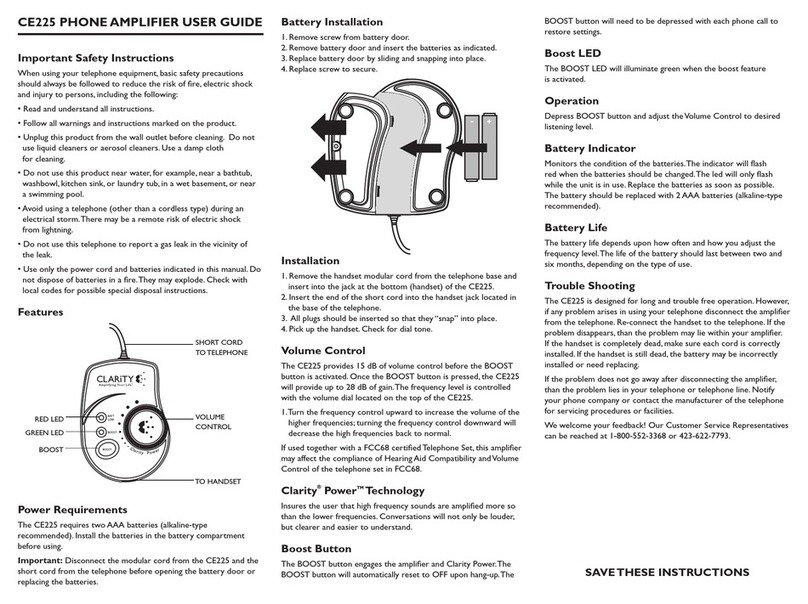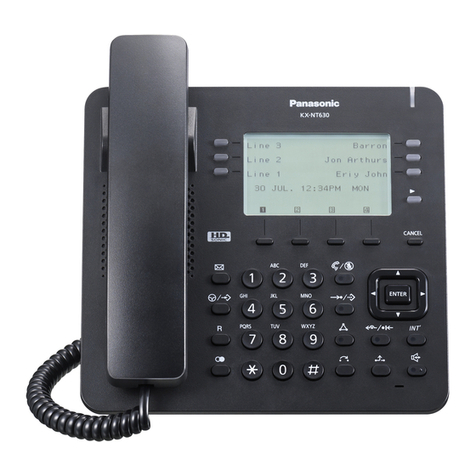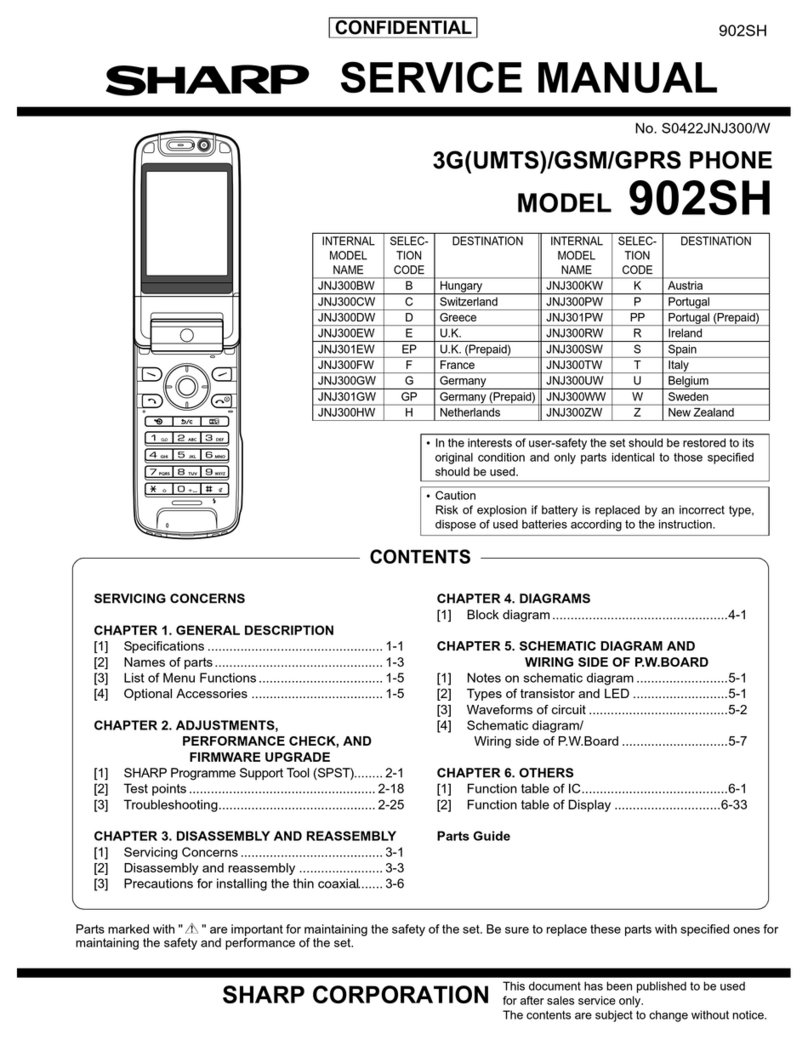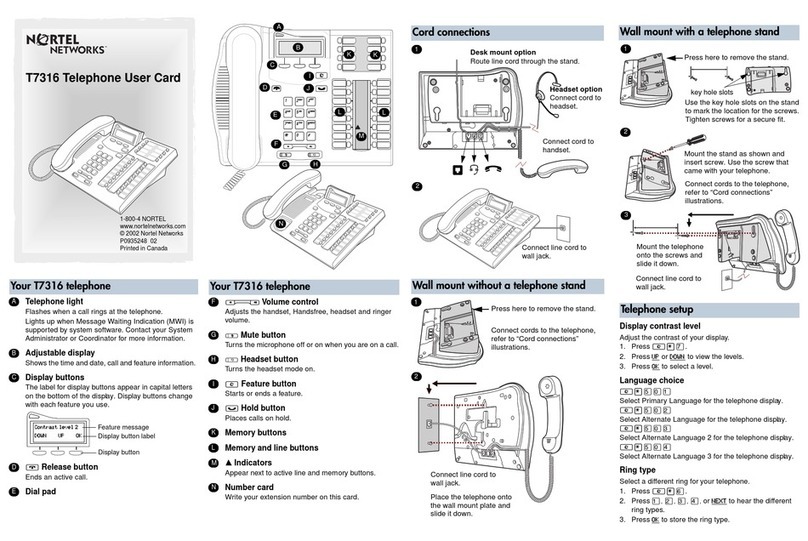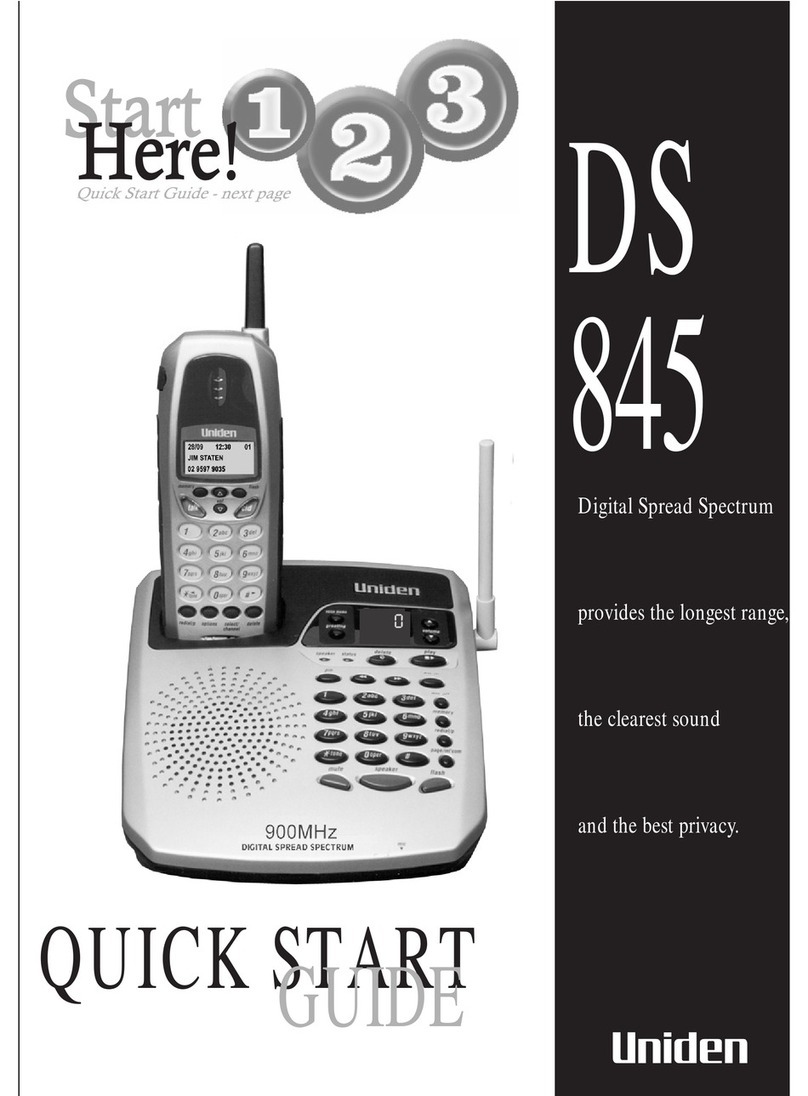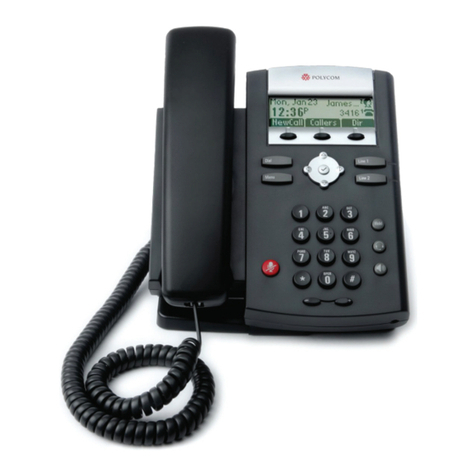Executone Systems MEDLEY Use and care manual


© 1997 EXECUTONE Information Systems, Inc.
All rights reserved. No part of this document may be reproduced,
distributed, or transmitted in any form, or by any means (graphic, electronic, or mechanical,
including photocopying, taping, or information storage and retrieval systems now known or as
may be hereafter developed) without written permission of EXECUTONE Information Sys-
tems.
Medley™ is a trademark of EXECUTONE Information Systems, Inc.
EXECUTONE®is a registered trademark of EXECUTONE Information Systems, Inc.
THE INFORMATION CONTAINED HEREIN IS SUBJECT TO CHANGE
WITHOUT NOTICE AS PROGRESS AND ENHANCEMENTS ARE MADE.
Printed in USA

1997 i
Table of Contents
1. Introduction..................................................................................................................1
1.1 Hardware.............................................................................................................. 1
1.2 System Design ..................................................................................................... 2
1.3 Call Processing Features...................................................................................... 5
1.4 Administrative Duties.......................................................................................... 8
2. System Programming Functions.................................................................................. 9
3. General Programming Procedures ............................................................................. 10
3.1 Entering Programming Mode ............................................................................ 10
3.2 Exiting Programming Mode .............................................................................. 10
3.3 Programming Keys ............................................................................................ 11
3.4 Inputting Alphabetic and Numeric Characters .................................................. 12
3.5 System Numbering Plan .................................................................................... 12
3.6 Accessing a User Station from that Station....................................................... 13
4. Specific Programming Procedures ............................................................................ 14
4.1 Function 1 System Parameters .......................................................................... 14
Function 13 Administrator Password ........................................................... 14
Function 14 Set Time.................................................................................... 14
Function 17 System Speed Dial.................................................................... 14
4.2 Function 3 Extension Programming .................................................................. 15
Function 32 Extension Feature Authorization .............................................. 15
4.3 Function 5 Voice Mail Programming................................................................ 16
Function 53 Guest / Information Mailboxes................................................. 16
Function 54 Group Mailboxes (including Broadcast) .................................. 17
Function 56 Cascade Paging Mailboxes....................................................... 18
4.4 Function 6 Recording ........................................................................................ 19
Function 61 Record System Prompts ........................................................... 19
Function 62 Record Directory Names .......................................................... 21
Function 63 Message On Hold Programming .............................................. 21

1997
ii
4.5 Function 7 Reports............................................................................................. 23
Function 72 Line / Auto Attendant Report ................................................... 23
Function 73 Extension / Department Report ................................................ 23
Function 74 Voice Mail Statistics Report..................................................... 23
Function 75 System Speed Dial Report........................................................ 23
5. Programming Tutorial................................................................................................ 24
Function 32 Extension Feature Authorization.............................................. 24
Function 53 Information Only Mailbox ....................................................... 25
Function 53 Guest Mailbox .......................................................................... 25
Function 54 Group Mailbox for One Owner ................................................ 26
Function 54 Group Mailbox for Multiple Owners ....................................... 26
Function 56 Cascade Paging Notification .................................................... 27

1997 1
1. INTRODUCTION
Medley™ is an advanced small business telephone system with built-in voice
processing, automated attendant and voice-mail capability. The system’s
combined functions are controlled by a single processor and by a single set of
proprietary operating system software. Its features and functions include the
following:
• A 16 x 34 digital telephone system
• 10 voice mail ports
• Automated attendant
• Automatic call distribution (ACD)
• Message on hold
• Caller ID
• Call traffic and call activity reports
Medley is a single system that performs both telephone and voice mail func-
tions using a single processor, storage medium, and voice processing DSP.
With no boundaries between these once separate tasks, Medley delivers the
greatest possible efficiency and cost effectiveness.
1.1 Hardware
Hardware consists of the system cabinet and power source, the optional expan-
sion cabinet, and up to 32 M64 phones.
System Cabinet and Power Source
The compact, wall-mounted cabinet houses the processor, memory, and station
interfaces. It is powered by a small external wall-mount transformer. The base
unit is capable of supporting up to eight CO lines, 16 feature phones, and two
analog ports.
Expansion Cabinet (Optional)
A piggyback expansion cabinet can be added for an additional 8 x 16 configu-
ration without increasing the system’s “footprint.”
M64 Phones
The M64 phones provide advanced call handling features, an LCD display, and
built-in speaker phone capability.

1997
2
1.2 System Design
The system includes the following design features:
Voice prompts and Voice prompts and the LCD display guide users
64-character LCD through programming and operation. The LCD
display display also shows such information as how
many new and old messages waiting in voice
mail, caller ID (if active), and how many calls
are holding for ACD agents.
Help The HELP key provides voice and LCD expla-
nations of programming and all commonly used
phone features.
Private line Lines are programmed to ring directly to a
preset station, department or mailbox.
Programmable keys These 15 lighted, programmable keys provide
one-touch transfer to stations, mailboxes, or
departments; direct line keys; speed dial; or
other feature access.
Line groups Each outbound line is assigned to a group. Icons
on a user’s LCD display shows how many lines
exist, whether or not each line is in use.
Guest extensions Guest extensions are voice mailboxes for
employees who work outside the office. A guest
extension makes it appear as if an off-site
employee has a live station in the office. People
calling the office phone system can be trans-
ferred to the extension.
Common audible One of the system’s analog ports can be desig-
nated to provide common audible (e.g. bell,
chime, etc.) ringing to provide simplified line
pickup from any station during the night mode.
Paging There are three built-in paging zones and one
all-page via a fixed feature key.

1997 3
External paging A CO line connection or one of two preassigned
interface analog ports can be used for simplified connec-
tion to external overhead paging equipment.
FAX transfer If a FAX tone is detected upon answer by the
auto attendant, the call will automatically be
transferred to the analog port set as a FAX
extension.
Remote system System updates are accomplished via a built-in
software updates 14.4 Kb modem. System software or built-in
voice prompts are factory updated through dial-
up rather than by costly and time-consuming
EPROM replacement. Dealers can also use the
modem port for remote real-time monitoring of
system activity and for debugging.
911 alert This feature provides immediate line access if
any station dials 911 to report an emergency. A
warning message will sound at extension 100
and the LCD display will show “911 CALL
FROM X102 JOHN JAMES”.
Call statistics Medley tracks call activity by line, extension,
and department. Medley also tracks voice mail
activity. The system administrator can print
reports.

1997
4
Voice mail The VM key provides one-stroke, immediate
connection to voice mail features, including the
following:
Automatic Mailbox Creation
From the moment a Medley system is up-and-
running, mailboxes are automatically created
with generic greeting and forwarding default
values for all users. If they want, users can then
create their own custom greetings.
Message Waiting Indication
The unit will automatically activate the phone’s
message light and provide a real time display on
LCD of type and number of messages.
Duration Display
As a message is played, the LCD display shows
its duration from the beginning of playback and
counts down to message completion.
Call Screening
A user can monitor incoming calls in the same
way as is done on a home answering machine. If
the user activates monitor mode, then when a
caller begins leaving a message, his or her voice
is output to the user’s speaker, giving the user
the option of intercepting the call or allowing
the message to be completed.
Personal Greeting Reminder
A user can activate this feature to automatically
play his or her personal greeting the first time
the phone is used after an absence, ensuring
removal of an outdated greeting. The user can
then keep or change the greeting.
Voice Groups
A user can leave a single message in several
user’s mailboxes by pressing the VM key and
then the desired station keys.

1997 5
1.3 Call Processing Features
Medley provides seamless operation and call processing. No hookflash or call
progress monitoring is required, resulting in the fastest call processing avail-
able.
Record conversations During any conversation, a user can press the
REC key and record the conversation for later
retrieval. Users can record personal reminders
by lifting the handset and pressing the REC key
on the phone.
Service observing Stations designated to observe can be allowed to
monitor conversations on specified stations.
Toll restriction You can limit user access to toll calls.
Day and night operation You can program both a day and a night main
greeting and day and night call processing for
automatic operation. The operator can manually
change between day, night, holiday, and auto-
matic modes with the press of a key.
Delayed ringing Delayed ringing options allow flexibility in
answering incoming calls. For example, an
incoming call intended for a sales person or
department can be sent to an administrator, and
ultimately to a chime for any available person to
answer. The feature is programmed on a line-by-
line basis.
Hold recall You can set the amount of time that elapses
between placing a call on park or hold and when
that party is recalled.
Auto attendant Auto attendant gives branch options for callers,
who press keys according to the information,
person, or department they want. Auto attendant
can have as many as eight options, down to six
levels deep.

1997
6
Message on hold Message on hold (MOH) allows for traditional
announcements or music to be played to callers
who are on hold. Three generic hold messages
are stored on disk. Up to five custom recordings
can be downloaded.
On-hold dialing If the MOH source is being generated by the
system, DTMF receivers continuously monitor
the line, allowing callers on hold or in ACD
queue to dial other options such as extensions or
the operator.
ACD Calls are presented to the longest idle ACD
agent or, if all agents are busy, callers are held
in queue and presented as agents become
available. Possibilities include up to 10 agent
groups with up to 32 agents in a group.
Caller ID With caller ID service activated, the name and
number of the calling party is displayed on
incoming calls and during call waiting. Addi-
tionally, the caller ID can be used for automatic
callback. Some limitation based on the service
provider and the local dialing patterns may exist.
Call waiting A second call to a station is indicated by an
audible tone and a display message.
Call pickup A user can answer another ringing station or a
common bell.
Call transferring You can perform both supervised and blind
transfers.
Call forwarding A call can be forwarded to another extension or
mailbox when the intended extension is busy or
not answered.
Conference calling Up to 12 parties can be in conferences at the
same time; up to four parties in a single confer-
ence. The originating extension must remain in
the conference.
Do not disturb A user can activate the feature with the single
press of the DND key while the phone is idle.

1997 7
Flash control System programming of the flash duration
provides for flexible usage behind central office
switches, Centrex, or PBXs.
Hands-free answer Station users can program their phone for hands-
free answer (voice announce) for station-to-
station calls.
Redial If an attempt at an outside call is unsuccessful,
press the single RDL key for any subsequent
attempts.
Line queuing Should a call be attempted when all outside lines
are busy, users can elect to be called back and
advised by voice announcement as soon as a line
becomes available.
System speed dial Up to 100 names and associated numbers are
stored at a system-wide level.
Mute This fixed key mutes the hands-free microphone
or handset microphone if pressed during a call.
ExecuDex ExecuDex is an electronic address book that lets
each station store up to 100 caller ID names and
numbers for auto dial.

1997
8
1.4 Administrative Duties
The system administrator’s duties can include the following:
• Assign stations to employees.
• Assign features to stations.
• Maintain any employee directory.
• Assign, edit, and delete special mailboxes: Guest/Information, Group, and
Cascade Paging.
• Rerecord prompts. Medley has all necessary prompts prerecorded to assist
in initial setup. You can rerecord some or all.
• Rerecord the main greeting.
• Changing between day and night modes.
• Printing statistical reports.
• Training new employees on the system. You should assist each user in
becoming familiar with station programming and learning to rely on the
verbal help mode.
Once the system has been programmed, day-to-day operation will go largely
unattended.

1997 9
2. SYSTEM PROGRAMMING FUNCTIONS
System Parameters
Administrator Password
Set Time
System Speed Dial
Extension Programming
Extension Feature Authorization
Voice Mail Programming
Guest / Information Mailboxes
Group Mailboxes
Cascade Paging Mailboxes
Recording
Record System Prompts
Record Directory Names
MOH Programming
MOH Source
Record MOH
MOH Volume
Reports
Line and Auto Attendant Statistics
Extension and Department Statistics
Voice Mail Statistics
System Speed Dial List

1997
10
3. GENERAL PROGRAMMING PROCEDURES
Any telephone can access Medley programming, but only one phone can be in
programming at a time. You can program Medley while the system is operat-
ing. In programming mode, you hear voice prompts from the telephone and you
see your options and choices on the LCD display. Once you get familiar with
the system, you don’t have to let a voice prompt complete before pressing a
key.
3.1 Entering Programming Mode
1. Press the MENU (F1) key.
2. PARK 3 (to stop the station programming prompt).
3. Input the administrator password. The default is “456.”
4. Press #.
While in programming mode, your extension is automatically placed in
DND until you exit programming mode.
3.2 Exiting Programming Mode
• Hang up the handset or press the HF key.

1997 11
3.3 Programming Keys
During programming, the top line of the LCD shows the current item being
programmed and the second line is the “input” line.
TO PRESS DESCRIPTION
Enter #Confirms a new or existing
entry and advances to the next
programming step.
When an option allows you to
input multiple entries (such as
a list of extension numbers),
you separate each entry by #.
Pressing ## exits the list.
Toggle PARK 3 Scrolls through possible
selections on the LCD display.
A “>” (greater than sign) at
the right of the display indi-
cates additional choices are
available.
Back up *Backs up to the previous
prompt without changing the
current prompt’s value.
Delete HOLD Deletes data or recording.
Help MENU (F1) When pressed during pro-
gramming, gives more de-
tailed instructions.
Exit • HF or Exits programming mode and
• Hang up handset removes the extension from
DND.

1997
12
3.4 Inputting Alphabetic and Numeric Characters
Names for extensions, departments, and branch IDs can be input by pressing
the dial pad key that corresponds to the character to be entered. The key’s
possible entries will change each time the key is pressed. When the desired
character is displayed, press # to confirm, and the cursor will move to the next
character position. Note that the “1” key options are Q, Z, a space, and 1.
Example: To input a ‘B’, press the ‘2’ key twice (the
possible options to scroll through are A, B, C, 2).
When B is displayed, press # to confirm and to move
to the next character to be input. Press the BACK key
to delete any errors. ## completes the name.
3.5 System Numbering Plan
The system’s fixed numbering plan is as shown:
1 to 16 CO Lines
100 Operator Extension (default)
100 to 131 User Extensions
191 to 192 Analog Extensions
200 to 209 Department Pilots
300 to 499 Guest / Information Mailboxes
500 Broadcast Mailbox
501 to 516 Group Mailboxes
520 to 529 Cascade Paging Mailboxes
530 to 550 Recordable System Prompts
560 to 563 Fixed Feature Keys
560 Manual Day/Night Key
561 Service Observing Key
562 ACD Agent Wrap Key
563 Caller ID ExecuDex Key
590 to 598 MOH Recordings
600 to 699 System Speed Dial

1997 13
3.6 Accessing a User Station from that Station
Should a user forget his password or if an employee leaves the organization,
this feature allows you to access the user station’s programming mode and
operate within it.
To access user station programming:
• From the user’s station, input the administrator password when the system
prompts for the user password.
Example: From station 105 entering 456# instead of
the user password (105#), will enter the station for user
programming (default passwords are used here for
example purposes).

1997
14
4. SPECIFIC PROGRAMMING PROCEDURES
This chapter explains the various programming functions. (To program, you
must first enter the program mode, as explained in Chapter 3, “General Pro-
gramming Procedures.”)
4.1 Function 1 System Parameters
Function 13 Administrator Password
This displays the existing password and prompts for a new one. The password
can be 2- to 8-digits long. Write down any new password in a safe place.
Default password = 456
Function 14 Set Time
A new time is input in a twelve hour format. Input “1233” for 12:33, or “315”
for 3:15. Select AM or PM by pressing the PARK 3 key.
NOTE: The system will maintain the correct time, even in the event of a
power loss. The date is installed at the factory and requires no updating.
Function 17 System Speed Dial
Up to 100 system speed dial names and associated numbers can be stored in
location numbers 600 to 699 for access by any station. System speed dial is
available to a station regardless of the station’s line access or toll restriction.
To enter a system speed dial number.
1. Enter the 3-digit bin number that you are programming.
2. Enter a 10-character name. This is required.
3. Enter the number to be dialed (including the line group 9, 8, or 7).
The number can be up to 30 digits long, including the characters #, *, F
(flash), or P (for a 2-second pause). These are inserted by pressing the
PARK 3 key to select the desired character. Press # to confirm the in-
serted character and continue. Press ## to complete the entry.
Press DEL to delete a number or name. To delete an entire speed dial
number and name, press DEL to delete the location number.

1997 15
4.2 Function 3 Extension Programming
Function 32 Extension Feature Authorization
You can allow or deny many features on an extension-by-extension basis.
Users can only program allowed features by using a combination of voice and
LCD prompts from their phone. Chapter 5, “Programming Tutorial,” gives
programming examples.
Steps for extension feature authorization:
1.Extension Number: Enter the extension number to program.
2.Extension Name: Name the extension (if not previously named).
For each of the following features, press the PARK3 key to select YES or NO.
See Chapter 1, “Introduction” and Chapter 5, “Programming Tutorial,” for a
detailed description of each.
3.Call Waiting: Allows the user to turn call waiting on or off for his station.
4.Do Not Disturb: Allows the user to activate DND from his station.
5.Auto Attendant Block: Blocks calls from being transferred to the station
from the auto attendant.
6.Live Recording Feature: If enabled, will allow the user to record conver-
sations.
7.Service Observing: Allows the user to monitor the conversations of those
stations listed in the service observing list for his station. If service
observing is YES, a list of allowed extensions must be input.
NOTE: A department number can be entered as an extension
in the service observing list and will then automatically include
all members of the department even if the members of the
department are later changed.
CAUTION: Federal law prohibits monitoring of personal
(nonbusiness) telephone calls.
8.Toll Restriction: Allows the user to place toll calls. If denied, the user can
only make non-toll calls or calls to numbers listed in the Allow Exception
table.

1997
16
4.3 Function 5 Voice Mail Programming
All programmed extensions have a generic personal greeting “You have
reached the mailbox for extension xxx”. This greeting should be replaced with
a personalized greeting by the mailbox user.
Function 53 Guest / Information Mailboxes
Mailboxes numbered from 300 to 499 can be programmed as either guest or
info mailboxes. Guest and info mailboxes are created or deleted here, but are
turned “on” only when a personal greeting (the information to be played) has
been recorded. Deleting the personal greeting will turn “off” the mailbox.
Guest Mailboxes
Guest mailboxes are designed to be used by personnel such as outside
sales or manufacturing personnel who do not have an extension assigned
to them. A guest mailbox requires no programming other than the name
assigned.
Default = 300 to 499 as guest
NOTE: A guest mailbox can be handled like a regular extension (e.g.
listed in the directory, assigned a station key, etc.).
A guest mailbox cannot have a message light. Messages are retrieved
from the outside by dialing * and the mailbox number during the main
greeting. Messages are retrieved from a station by pressing the
VOICEMAIL key, *, and the mailbox number.
Information Mailboxes
Information mailboxes can be used to give callers information on a
variety of different subjects by “publishing” these mailbox numbers.
Information mailboxes are identical to guest mailboxes except that the
caller will not be given a record tone after the personal greeting (the
information to be played). Instead, the caller will be forwarded as pro-
grammed in this function (default is the caller will be disconnected after
the information is played).
Maximum length of the record time = 14 minutes
Table of contents
